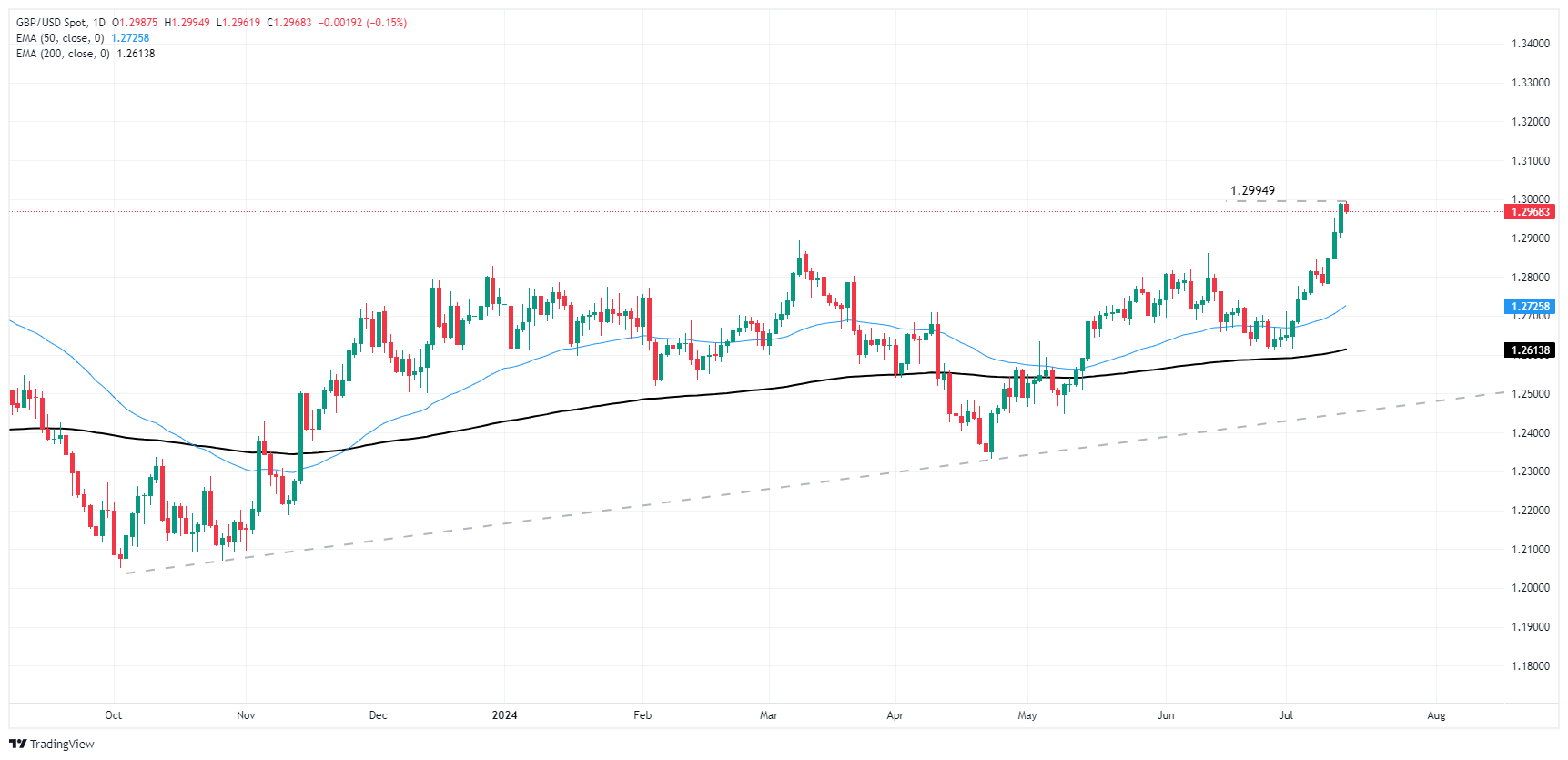GBP/USD snaps winning streak on Monday as bidders shy away from 1.30


- GBP/USD chilled a three-day win streak, kicks off new week with a cautious tone.
- Fedspeak drives broader market sentiment as investors hope for rate cuts.
- US Retail Sales, UK CPI inflation round the corner into the midweek.
GBP/USD took a breather from bullish momentum on Monday, pulling back just shy of the 1.3000 handle after FX markets took a break from Greenback selling to reconsider recent moves and re-weigh odds of a September rate cut from the US Federal Reserve (Fed).
Forex Today: Markets’ attention shifts to data and Fedspeak
Fedspeak dominated market focus to kick off the new trading week, with Fed Chairman Jerome Powell giving a nod of the head to recent progress on inflation. Fed Chair Powell was followed up by a low-impact appearance from San Francisco Fed President Mary Daly, and both key Fed policymakers reiterated a lack of forward guidance on the timing of Fed rate cuts, doubling down on how decisions would be made on a meeting-by-meeting basis.
According to the CME’s FedWatch Tool, rate markets are pinning all of their hopes on a September rate cut. Rate markets have fully priced in a September rate trim, with 100% odds of at least a 25 basis point decline in the fed funds rate when the Federal Open Market Committee (FOMC) meets on September 18.
US Retail Sales on Tuesday will wrap up the recent bout of US key data releases from the past week, and markets are expecting a continued cooling in US activity data. US Retail Sales are forecast to flatten to 0.0.% MoM in June.
Early Wednesday will bring the latest iteration of UK Consumer Price Index (CPI) inflation, with MoM headline CPI inflation in June expected to tick down to 0.1% from 0.3%. After that will be UK labor and wages figures on Thursday, and Friday will wrap up the GBP’s representation on the economic data docket with UK Retail Sales.
GBP/USD technical outlook
Cable bidding took a break on Monday, snapping a three-day winning streak and etching in a thin bearish candle after the pair closed in the green for all but two of the previous 12 consecutive trading days. GBP/USD’s swing low towards 1.2600 in late June failed to pierce the major price handle, sending bullish bids higher, and Monday trading managed to eke out a fresh 12-month high at 1.29949 before pulling back and rotating lower just shy of the 1.3000 key price level.
GBP/USD daily chart
Pound Sterling FAQs
What is the Pound Sterling?
The Pound Sterling (GBP) is the oldest currency in the world (886 AD) and the official currency of the United Kingdom. It is the fourth most traded unit for foreign exchange (FX) in the world, accounting for 12% of all transactions, averaging $630 billion a day, according to 2022 data. Its key trading pairs are GBP/USD, aka ‘Cable’, which accounts for 11% of FX, GBP/JPY, or the ‘Dragon’ as it is known by traders (3%), and EUR/GBP (2%). The Pound Sterling is issued by the Bank of England (BoE).
How do the decisions of the Bank of England impact on the Pound Sterling?
The single most important factor influencing the value of the Pound Sterling is monetary policy decided by the Bank of England. The BoE bases its decisions on whether it has achieved its primary goal of “price stability” – a steady inflation rate of around 2%. Its primary tool for achieving this is the adjustment of interest rates. When inflation is too high, the BoE will try to rein it in by raising interest rates, making it more expensive for people and businesses to access credit. This is generally positive for GBP, as higher interest rates make the UK a more attractive place for global investors to park their money. When inflation falls too low it is a sign economic growth is slowing. In this scenario, the BoE will consider lowering interest rates to cheapen credit so businesses will borrow more to invest in growth-generating projects.
How does economic data influence the value of the Pound?
Data releases gauge the health of the economy and can impact the value of the Pound Sterling. Indicators such as GDP, Manufacturing and Services PMIs, and employment can all influence the direction of the GBP. A strong economy is good for Sterling. Not only does it attract more foreign investment but it may encourage the BoE to put up interest rates, which will directly strengthen GBP. Otherwise, if economic data is weak, the Pound Sterling is likely to fall.
How does the Trade Balance impact the Pound?
Another significant data release for the Pound Sterling is the Trade Balance. This indicator measures the difference between what a country earns from its exports and what it spends on imports over a given period. If a country produces highly sought-after exports, its currency will benefit purely from the extra demand created from foreign buyers seeking to purchase these goods. Therefore, a positive net Trade Balance strengthens a currency and vice versa for a negative balance.





